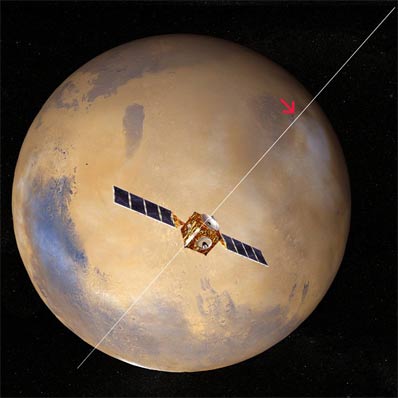
Spaceflight Now +

|

|

|

|

Premium video content for our Spaceflight Now Plus subscribers.

Discovery demate preps
 Technicians ready space shuttle Discovery for demating from the external fuel tank inside the Vehicle Assembly Building. (1min 24sec file) Technicians ready space shuttle Discovery for demating from the external fuel tank inside the Vehicle Assembly Building. (1min 24sec file)
 Play video Play video

Shuttle removed from tank
 Space shuttle Discovery is demated from its original external fuel tank and solid rocket boosters. The ship is lowered to its transport trailer in the Vehicle Assembly Building. (2min 38sec file) Space shuttle Discovery is demated from its original external fuel tank and solid rocket boosters. The ship is lowered to its transport trailer in the Vehicle Assembly Building. (2min 38sec file)
 Play video Play video

Discovery in the VAB
 Shuttle Discovery enters into the Vehicle Assembly Building after a 10-hour journey from launch pad 39B. (4min 29sec file) Shuttle Discovery enters into the Vehicle Assembly Building after a 10-hour journey from launch pad 39B. (4min 29sec file)
 Play video Play video

Memorial Day message
 The International Space Station's Expedition 11 crew pays tribute to our fallen heroes for Memorial Day. (1min 00sec QuickTime file) The International Space Station's Expedition 11 crew pays tribute to our fallen heroes for Memorial Day. (1min 00sec QuickTime file)
 Play video Play video

Apollo-era transporter
 In the predawn hours, the Apollo-era crawler-transporter is driven beneath shuttle Discovery's mobile launch platform at pad 39B in preparation for the rollback to the Vehicle Assembly Building. (2min 37sec QuickTime file) In the predawn hours, the Apollo-era crawler-transporter is driven beneath shuttle Discovery's mobile launch platform at pad 39B in preparation for the rollback to the Vehicle Assembly Building. (2min 37sec QuickTime file)
 Play video Play video

Unplugging the shuttle
 Workers disconnect a vast number of umbilicals running between launch pad 39B and Discovery's mobile launch platform for the rollback. The cabling route electrical power, data and communications to the shuttle. (2min 32sec file) Workers disconnect a vast number of umbilicals running between launch pad 39B and Discovery's mobile launch platform for the rollback. The cabling route electrical power, data and communications to the shuttle. (2min 32sec file)
 Play video Play video

Shuttle rollback
 The crawler-transporter begins rolling space shuttle Discovery off launch pad 39B at 6:44 a.m. EDT May 26 for the 4.2-mile trip back to the Vehicle Assembly Building. (7min 28sec file) The crawler-transporter begins rolling space shuttle Discovery off launch pad 39B at 6:44 a.m. EDT May 26 for the 4.2-mile trip back to the Vehicle Assembly Building. (7min 28sec file)
 Play video Play video

Voyager adventures
 This animation shows the Voyager spacecraft heading into the solar system's final frontier and the edge of interstellar space. (1min 24sec file) This animation shows the Voyager spacecraft heading into the solar system's final frontier and the edge of interstellar space. (1min 24sec file)
 Play video Play video

Mike Griffin at KSC
 NASA Administrator Mike Griffin and Kennedy Space Center Director Jim Kennedy chat with reporters at the Cape on a wide range of topics. The press event was held during Griffin's tour of the spaceport. (27min 48sec file) NASA Administrator Mike Griffin and Kennedy Space Center Director Jim Kennedy chat with reporters at the Cape on a wide range of topics. The press event was held during Griffin's tour of the spaceport. (27min 48sec file)
 Play video Play video

Delta rocket blasts off
 The NOAA-N weather satellite is launched aboard a Boeing Delta 2 rocket from Vandenberg Air Force Base, California. The NOAA-N weather satellite is launched aboard a Boeing Delta 2 rocket from Vandenberg Air Force Base, California.

 Play video: Play video:
Liftoff | Extended clip
Umbilicals | IR tracker

 Become a subscriber Become a subscriber
 More video More video

|

|

|

|
|

|

European Space Agency approves Mars boom deploy
EUROPEAN SPACE AGENCY NEWS RELEASE
Posted: June 7, 2005
Following in-depth analyses performed after the deployment of the first MARSIS antenna boom on board Mars Express, the European Space Agency has decided to proceed with the deployment of the second 20-metre antenna boom.

The second antenna of the Mars Express radar MARSIS (indicated by the red arrow) is due to be deployed in mid-June. Credit: ESA
|
The full operation will be performed during a time frame starting 13 June and nominally ending on 21 June.
A delay in the execution of the second boom deployment was necessary, due to problems encountered with the first deployment in early May this year. During the deployment, one of the antenna hinges (the tenth) got stuck in an unlocked position. Analysis of data obtained from earlier ground testing suggested a potential solution.
The Mars Express spacecraft control team at ESAıs Spacecraft Operations Centre (ESOC) succeeded in unblocking the hinge by exposing the cold side of the boom to the Sun. This warmed the hinges and the boom quickly became unstuck. In the end, the first boom deployment was completed on 10 May.
The lessons learnt during the first boom deployment were used to run new simulations and determine a new deployment scenario for the second boom. This scenario contains an additional sun-heating phase, to get the best possible thermal conditions for all hinges.
The deployment of the third (7-metre) third MARSIS boom is not considered critical. It will be commanded only once the ESA ground control team have re-acquired signal from the spacecraft, and made sure with a sequence of tests that the second boom is correctly locked into position and the spacecraft is well under control.
After this event MARSIS, the Mars Express Sub-Surface Radar Altimeter, will enter into a commissioning phase for the next few weeks, before starting to look at Marsıs ionosphere during martian daylight, and to probe down below the Martian surface during the martian night.
|

|

|

|


|



